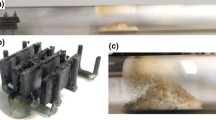Abstract
A model has been developed of the behaviour of hydrogen in enamelling-grade steels in relation to the delayed defect of blow-off of enamelled surface (fishscaling). The model is based on current theories concerning reversible and irreversible trapping of hydrogen in metallic materials. It leads to the establishment of a “free hydrogen” parameterC L which can be used to assess the susceptibility of a steel to fishscaling following the usual enamelling processess. The model can also be used to study the effect of both thermomechanical steelmaking cycles and enamelling processes on resistance to the defect.
Similar content being viewed by others
Abbreviations
- E aD :
-
Activation energy of hydrogen diffusion through normal lattice
- E s :
-
Saddle-point energy
- E B :
-
Trap binding energy
- E aT :
-
Trap activation energy=Es+EB
- A:
-
Trapping site
- B:
-
Normal lattice site
- v 0 :
-
Vibration frequency of hydrogen at a normal lattice site
- v 1 :
-
Vibration frequency of hydrogen at a trapping site
- N L :
-
Density of normal lattice sites for hydrogen
- N T :
-
Density of trapping sites for hydrogen
- C L :
-
Concentration of hydrogen on lattice sites
- C T :
-
Concentration of hydrogen captured on traps
- k :
-
Probability of trapping=v0 exp(−E s/R T)
- p :
-
Probability of detrapping =v 1 N L exp (−E aT/R T)
- n :
-
Fraction of trapping sites occupied with hydrogen atoms among the total trapping sites=C T/N T
- t :
-
Time
- T :
-
Temperature
- R :
-
Gas constant
References
K. H. Marshall andD. White, “Vitreous Enamelling” (Pergamon, Oxford, 1986) p. 58.
M. A. V. Devanathan andZ. Stachurski,Proc. R. Soc. 270 (1962) 90.
G. Bassano, P. Degregorio, G. Fierro, F. Gastaldo andP. Zamproni, in Proceedings, “XV International Enameller's Congreess”, Praha, June 1989 (Kolektiv, DT3971) p. 171.
A. McNabb, andP. K. Foster,Trans. TMS-AIME 227 (1963) 618.
J. P. Hirt,Met. Trans. 11A (1980) 861.
G. M. Pressouyre andI. M. Bernstein,ibid. 9A (1978) 1571.
J.-L. Lee andJ.-Y. Lee ibid. 17A (1986) 2183.
M. Iino,ibid. 16A (1985) 401.
E. Lunarska, in “Hydrogen Degradation of Ferrous Alloys” R. A. Oriani, J. P. Hirt and M. Smialowski (eds) (Noyes, Park Ridge, 1985) p. 712.
R. A. Oriani,Acta Metall. 18 (1970) 147.
Author information
Authors and Affiliations
Rights and permissions
About this article
Cite this article
Valentini, R., Solina, A., Paganini, L. et al. Model of hydrogen behaviour in enamelling grade steels. J Mater Sci 27, 6579–6582 (1992). https://doi.org/10.1007/BF01165939
Received:
Accepted:
Issue Date:
DOI: https://doi.org/10.1007/BF01165939




